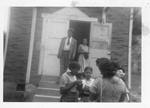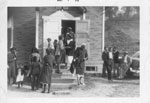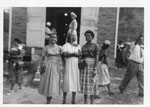The first families of Dry Fork made their living from farming and logging and whatever work was available to them. Their community began to develop and the institutions of Church and school were established by the turn of the century. Land, church, and school were the framework of the community and key to success in America. Israel Cross, a leader of freedmen community in Eastern Virginia knew this truth and spoke of it often. He “ farmed for six days and preached on Sunday. He ended every sermon with ‘Buy some land, build a home, and get some education.’” The first settlers of upper Dry Fork used the log school house for worship services and learned the practices and beliefs of the AME Zion Church. They then realized the need to build their own church building. A.J. and Emma Tynes donated land, and members from every family donated timber and labor and by 1901 the original Tynes Chapel was constructed. The first trustees were A.J. Tynes, Mack H. Ferguson, John R. Seay, Rueben Ferguson, and Mack Daniel Ferguson. Logs were donated by Sandy Sheilds, A.J. Tynes, Henry Gray, Humphrey Hogan, and several of the Ferguson clan. Powell Saunders cut the logs at his sawmill and construction began with Mr. Hogan driving the first nail into a log held by Mr. William Charlton. So began the birth of Tynes Chapel. There were many pastors over the years. Among those remembered was the Reverend Sheffey who walked across the mountain to preach. The most beloved was the Reverend Samuel Porter, who served the congregation for over 30 years. From 1931 to 1985 he pastored his Dry Fork flock and several additions were made to the church. In 1981 adjacent land was deeded to the Tynes Chapel and plans were made to build a new church. Over the next decades the new building was constructed and finished.
Early in the century the Dry Fork Baptist Church was built across the creek from Tynes Chapel. Services were held every other Sunday and even though certain families belonged to one or the other, they would attend each other's church. A dam was built to make a deep pool and baptisms were held in the creek . Aubrey Gore tells a story of one especially memorable Baptist preacher.
?We have had some memorable stories come out of here. We had a preacher named Reverend Wilson who used to preach at the old Baptist church. He was preachin’ one Sunday and they had a old pot belly stove, and he got to preachin,’ and he was one of the fiery preachers, and he jumped out of the pulpit and hit on his knees, and he hit so hard it knocked the stove over in the church and the church filled with smoke. It was a fire and brimstone sermon for sure.?
Dinners were held in the Church yard after services in the summer and were great social events. They also are remembered as culinary legends as each family brought food to be spread on the tables for all. In the summer families would return to Dry Fork from Ohio, and New Jersey, and Pennsylvania. There would be gatherings and reunions at the church, and down at the recreation area at M.H. Ferguson’s place. Aubrey Gore remembers in the 1950’s and 1960’s the homecomings as being the social event of the year.
“The fondest memory of the church was we used to have a homecomings on church anniversary, and people would come in from all over and there was just as many people outside the church as inside, and even though I was a kid and vaguely remember, we had a park and that was the place to come for black people and you would see bus loads of people come in. It was packed. People cooked food and they partied even though it was a church event, ya know people had the homecoming in the church and outside the church.”
It was homecoming for many. Families would return in the summer. It was a celebration of community. Tynes Chapel and the Dry Fork Baptist Church served as beacons for many years to the people of Dry Fork. In the summer of 1999 the last remains of the Baptist Church were torn down. Now only Tynes Chapel remains.
Would you like to return to the top of the page?
copyright©bland county history archives all rights reserved 2000




